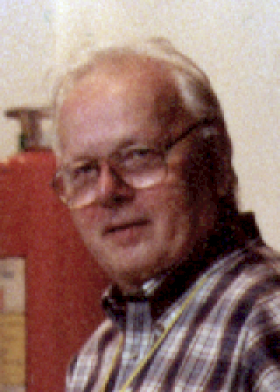
Computer science is the study of computation, information, and automation. Computer science spans theoretical disciplines to applied disciplines. Though more often considered an academic discipline, computer science is closely related to computer programming.

Niklaus Emil Wirth was a Swiss computer scientist. He designed several programming languages, including Pascal, and pioneered several classic topics in software engineering. In 1984, he won the Turing Award, generally recognized as the highest distinction in computer science, "for developing a sequence of innovative computer languages".

Simula is the name of two simulation programming languages, Simula I and Simula 67, developed in the 1960s at the Norwegian Computing Center in Oslo, by Ole-Johan Dahl and Kristen Nygaard. Syntactically, it is an approximate superset of ALGOL 60, and was also influenced by the design of Simscript.

The Z notation is a formal specification language used for describing and modelling computing systems. It is targeted at the clear specification of computer programs and computer-based systems in general.

Norwegian Computing Center is a private, independent, non-profit research foundation. NR carries out contract research and development in the areas of computing and quantitative methods for a broad range of industrial, commercial and public service organizations in Norway and internationally. NR is one of Europe's largest research environments in applied statistics and its projects cover a large variety of applied and academic problems. NR's offices are located near the university campus Blindern in Oslo, and adjacent to Oslo Science Park (Forskningsparken).

Ole-Johan Dahl was a Norwegian computer scientist. Dahl was a professor of computer science at the University of Oslo and is considered to be one of the fathers of Simula and object-oriented programming along with Kristen Nygaard.

Kristen Nygaard was a Norwegian computer scientist, programming language pioneer, and politician. Internationally, Nygaard is acknowledged as the co-inventor of object-oriented programming and the programming language Simula with Ole-Johan Dahl in the 1960s. Nygaard and Dahl received the 2001 A. M. Turing Award for their contribution to computer science.

Ivar Hjalmar Jacobson is a Swedish computer scientist and software engineer, known as major contributor to UML, Objectory, Rational Unified Process (RUP), aspect-oriented software development and Essence.

Daniel Henry Holmes Ingalls Jr. is a pioneer of object-oriented computer programming and the principal architect, designer and implementer of five generations of Smalltalk environments. He designed the bytecoded virtual machine that made Smalltalk practical in 1976. He also invented bit blit, the general-purpose graphical operation that underlies most bitmap computer graphics systems today, and pop-up menus. He designed the generalizations of BitBlt to arbitrary color depth, with built-in scaling, rotation, and anti-aliasing. He made major contributions to the Squeak version of Smalltalk, including the original concept of a Smalltalk written in itself and made portable and efficient by a Smalltalk-to-C translator.
The International Federation for Information Processing (IFIP) is a global organisation for researchers and professionals working in the field of computing to conduct research, develop standards and promote information sharing.
In object-oriented programming, inheritance is the mechanism of basing an object or class upon another object or class, retaining similar implementation. Also defined as deriving new classes from existing ones such as super class or base class and then forming them into a hierarchy of classes. In most class-based object-oriented languages like C++, an object created through inheritance, a "child object", acquires all the properties and behaviors of the "parent object", with the exception of: constructors, destructors, overloaded operators and friend functions of the base class. Inheritance allows programmers to create classes that are built upon existing classes, to specify a new implementation while maintaining the same behaviors, to reuse code and to independently extend original software via public classes and interfaces. The relationships of objects or classes through inheritance give rise to a directed acyclic graph.

Luca Andrea Cardelli is an Italian computer scientist who is a research professor at the University of Oxford, UK. Cardelli is well known for his research in type theory and operational semantics. Among other contributions, in programming languages, he helped design the language Modula-3, implemented the first compiler for the (non-pure) functional language ML, defined the concept of typeful programming, and helped develop the experimental language Polyphonic C#.

NUSSE was the first Norwegian electronic computer.

Arne Sølvberg is a Norwegian computer scientist, professor in computer science at the Norwegian University of Science and Technology (NTNU) in Trondheim, Norway, and an expert in the field of information modelling.
Kari Onni Uolevi Karhunen was a Finnish probabilist and a mathematical statistician. He is best known for the Karhunen–Loève theorem and Karhunen–Loève transform.
Janis Askolds Bubenko junior was a Swedish computer scientist and Professor Emeritus at the Department of Computer and Systems Science, Royal Institute of Technology and Stockholm University.
Susanne Bødker is a Danish computer scientist known for her contributions to human–computer interaction, computer-supported cooperative work, and participatory design, including the introduction of activity theory to human–computer interaction. She is a professor of computer science at Aarhus University, and a member of the CHI Academy.

The Department of Informatics at the University of Oslo is the oldest and largest department for informatics in Norway. The department was in 2017 ranked number 1 in Norway, 3rd in Europe, and 12th in the world in Computer Science and Engineering by Academic Ranking of World Universities.













